Accounting Project: Dual Entry Accounting, Bank Reconciliation
VerifiedAdded on 2023/06/09
|18
|3752
|53
Homework Assignment
AI Summary
This accounting project delves into the fundamental principles of accounting, emphasizing the dual-entry system. It meticulously details the process of recording, summarizing, and analyzing financial transactions within an organization. The project covers the creation of journal entries, the use of ledgers to organize transactions, and the preparation of a trial balance to ensure the mathematical accuracy of the accounting records. Furthermore, it includes a bank reconciliation statement to reconcile the company's cash balance with the bank's records. The project also addresses the roles of control and suspense accounts and reconciles accounts receivable and payable, providing a comprehensive overview of essential accounting practices. The project demonstrates the practical application of accounting methods to monetary transactions, showing how these methods are used to manage financial events for smooth business operations.

UNIT 10
Paraphrase This Document
Need a fresh take? Get an instant paraphrase of this document with our AI Paraphraser
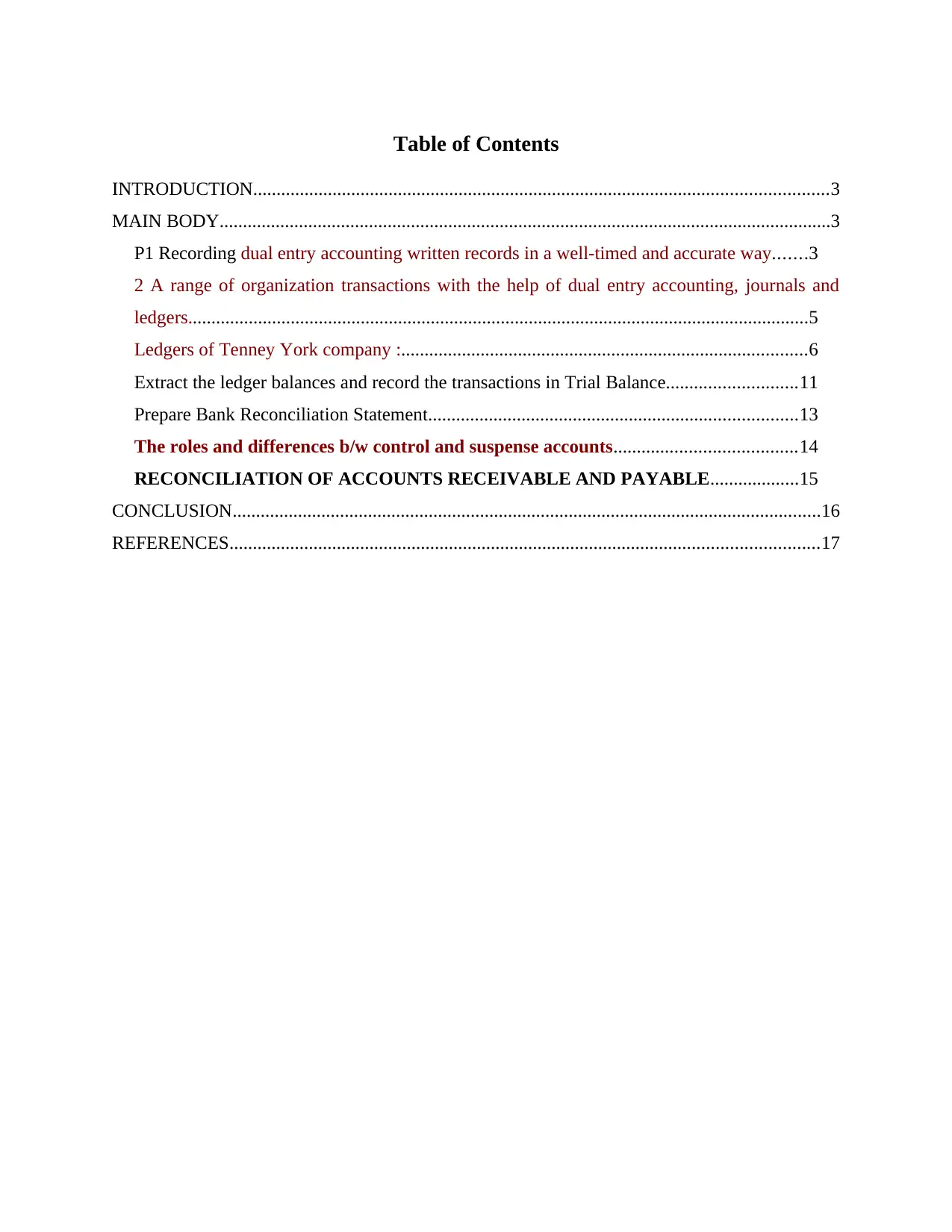
Table of Contents
INTRODUCTION...........................................................................................................................3
MAIN BODY...................................................................................................................................3
P1 Recording dual entry accounting written records in a well-timed and accurate way.......3
2 A range of organization transactions with the help of dual entry accounting, journals and
ledgers.....................................................................................................................................5
Ledgers of Tenney York company :.......................................................................................6
Extract the ledger balances and record the transactions in Trial Balance............................11
Prepare Bank Reconciliation Statement...............................................................................13
The roles and differences b/w control and suspense accounts.......................................14
RECONCILIATION OF ACCOUNTS RECEIVABLE AND PAYABLE...................15
CONCLUSION..............................................................................................................................16
REFERENCES..............................................................................................................................17
INTRODUCTION...........................................................................................................................3
MAIN BODY...................................................................................................................................3
P1 Recording dual entry accounting written records in a well-timed and accurate way.......3
2 A range of organization transactions with the help of dual entry accounting, journals and
ledgers.....................................................................................................................................5
Ledgers of Tenney York company :.......................................................................................6
Extract the ledger balances and record the transactions in Trial Balance............................11
Prepare Bank Reconciliation Statement...............................................................................13
The roles and differences b/w control and suspense accounts.......................................14
RECONCILIATION OF ACCOUNTS RECEIVABLE AND PAYABLE...................15
CONCLUSION..............................................................................................................................16
REFERENCES..............................................................................................................................17
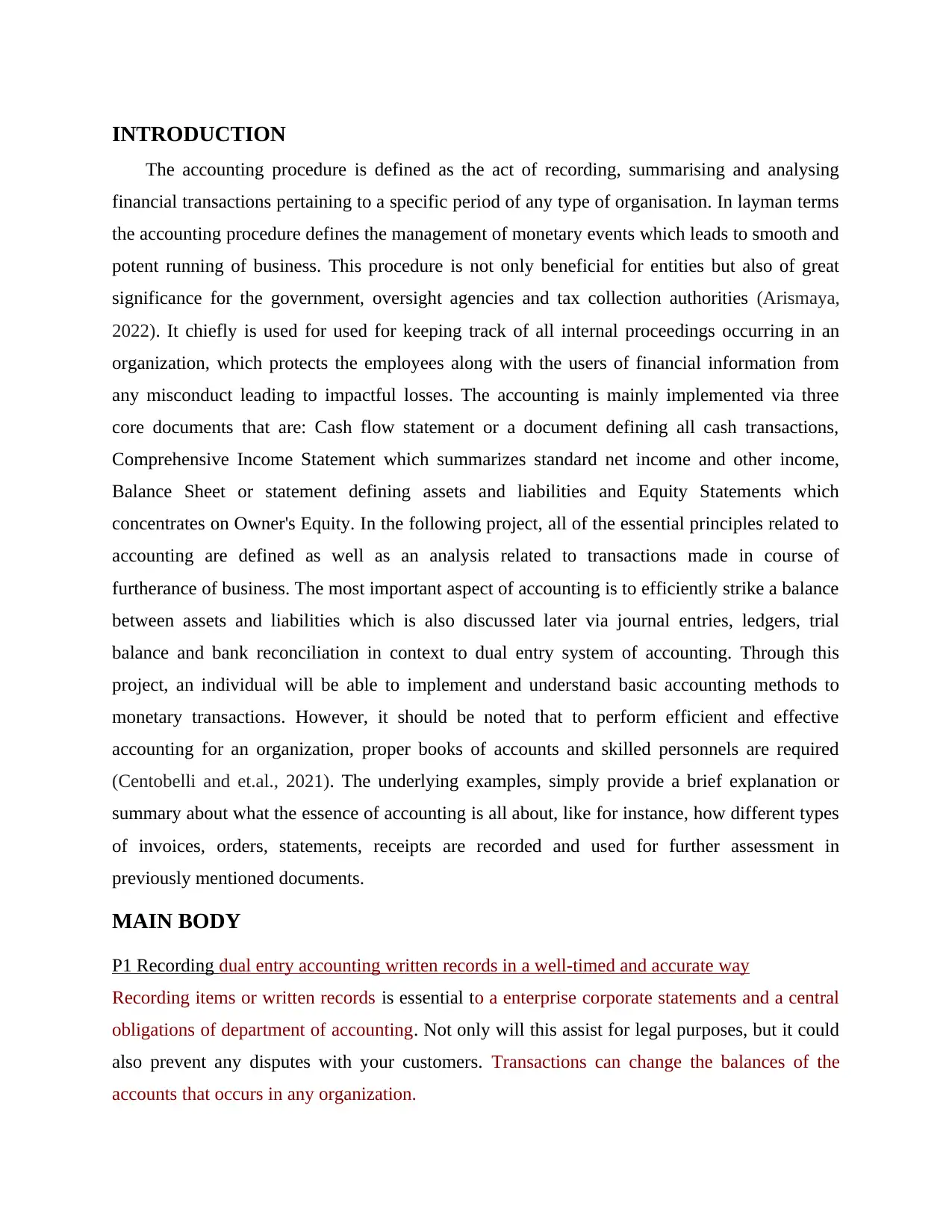
INTRODUCTION
The accounting procedure is defined as the act of recording, summarising and analysing
financial transactions pertaining to a specific period of any type of organisation. In layman terms
the accounting procedure defines the management of monetary events which leads to smooth and
potent running of business. This procedure is not only beneficial for entities but also of great
significance for the government, oversight agencies and tax collection authorities (Arismaya,
2022). It chiefly is used for used for keeping track of all internal proceedings occurring in an
organization, which protects the employees along with the users of financial information from
any misconduct leading to impactful losses. The accounting is mainly implemented via three
core documents that are: Cash flow statement or a document defining all cash transactions,
Comprehensive Income Statement which summarizes standard net income and other income,
Balance Sheet or statement defining assets and liabilities and Equity Statements which
concentrates on Owner's Equity. In the following project, all of the essential principles related to
accounting are defined as well as an analysis related to transactions made in course of
furtherance of business. The most important aspect of accounting is to efficiently strike a balance
between assets and liabilities which is also discussed later via journal entries, ledgers, trial
balance and bank reconciliation in context to dual entry system of accounting. Through this
project, an individual will be able to implement and understand basic accounting methods to
monetary transactions. However, it should be noted that to perform efficient and effective
accounting for an organization, proper books of accounts and skilled personnels are required
(Centobelli and et.al., 2021). The underlying examples, simply provide a brief explanation or
summary about what the essence of accounting is all about, like for instance, how different types
of invoices, orders, statements, receipts are recorded and used for further assessment in
previously mentioned documents.
MAIN BODY
P1 Recording dual entry accounting written records in a well-timed and accurate way
Recording items or written records is essential to a enterprise corporate statements and a central
obligations of department of accounting. Not only will this assist for legal purposes, but it could
also prevent any disputes with your customers. Transactions can change the balances of the
accounts that occurs in any organization.
The accounting procedure is defined as the act of recording, summarising and analysing
financial transactions pertaining to a specific period of any type of organisation. In layman terms
the accounting procedure defines the management of monetary events which leads to smooth and
potent running of business. This procedure is not only beneficial for entities but also of great
significance for the government, oversight agencies and tax collection authorities (Arismaya,
2022). It chiefly is used for used for keeping track of all internal proceedings occurring in an
organization, which protects the employees along with the users of financial information from
any misconduct leading to impactful losses. The accounting is mainly implemented via three
core documents that are: Cash flow statement or a document defining all cash transactions,
Comprehensive Income Statement which summarizes standard net income and other income,
Balance Sheet or statement defining assets and liabilities and Equity Statements which
concentrates on Owner's Equity. In the following project, all of the essential principles related to
accounting are defined as well as an analysis related to transactions made in course of
furtherance of business. The most important aspect of accounting is to efficiently strike a balance
between assets and liabilities which is also discussed later via journal entries, ledgers, trial
balance and bank reconciliation in context to dual entry system of accounting. Through this
project, an individual will be able to implement and understand basic accounting methods to
monetary transactions. However, it should be noted that to perform efficient and effective
accounting for an organization, proper books of accounts and skilled personnels are required
(Centobelli and et.al., 2021). The underlying examples, simply provide a brief explanation or
summary about what the essence of accounting is all about, like for instance, how different types
of invoices, orders, statements, receipts are recorded and used for further assessment in
previously mentioned documents.
MAIN BODY
P1 Recording dual entry accounting written records in a well-timed and accurate way
Recording items or written records is essential to a enterprise corporate statements and a central
obligations of department of accounting. Not only will this assist for legal purposes, but it could
also prevent any disputes with your customers. Transactions can change the balances of the
accounts that occurs in any organization.
⊘ This is a preview!⊘
Do you want full access?
Subscribe today to unlock all pages.

Trusted by 1+ million students worldwide
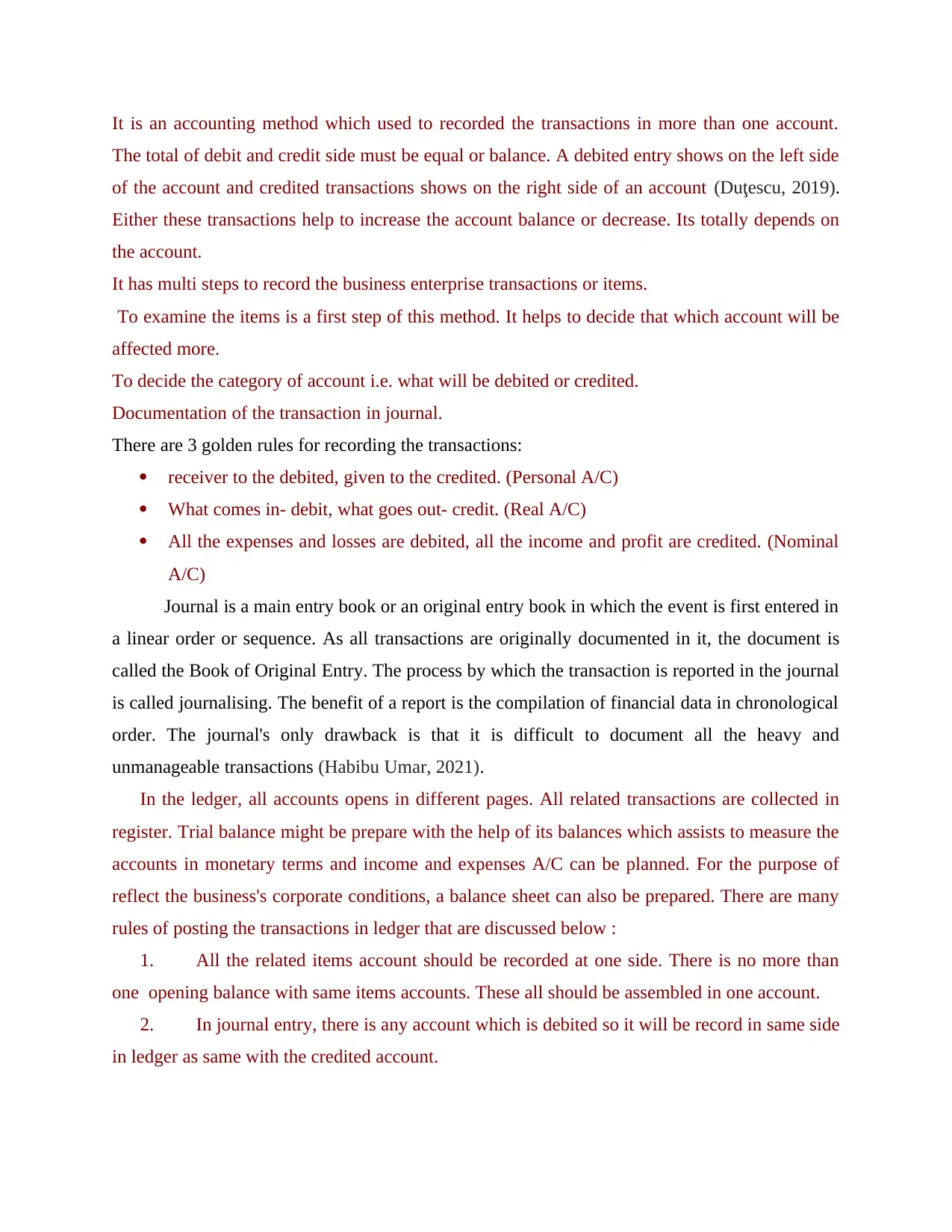
It is an accounting method which used to recorded the transactions in more than one account.
The total of debit and credit side must be equal or balance. A debited entry shows on the left side
of the account and credited transactions shows on the right side of an account (Duţescu, 2019).
Either these transactions help to increase the account balance or decrease. Its totally depends on
the account.
It has multi steps to record the business enterprise transactions or items.
To examine the items is a first step of this method. It helps to decide that which account will be
affected more.
To decide the category of account i.e. what will be debited or credited.
Documentation of the transaction in journal.
There are 3 golden rules for recording the transactions:
receiver to the debited, given to the credited. (Personal A/C)
What comes in- debit, what goes out- credit. (Real A/C)
All the expenses and losses are debited, all the income and profit are credited. (Nominal
A/C)
Journal is a main entry book or an original entry book in which the event is first entered in
a linear order or sequence. As all transactions are originally documented in it, the document is
called the Book of Original Entry. The process by which the transaction is reported in the journal
is called journalising. The benefit of a report is the compilation of financial data in chronological
order. The journal's only drawback is that it is difficult to document all the heavy and
unmanageable transactions (Habibu Umar, 2021).
In the ledger, all accounts opens in different pages. All related transactions are collected in
register. Trial balance might be prepare with the help of its balances which assists to measure the
accounts in monetary terms and income and expenses A/C can be planned. For the purpose of
reflect the business's corporate conditions, a balance sheet can also be prepared. There are many
rules of posting the transactions in ledger that are discussed below :
1. All the related items account should be recorded at one side. There is no more than
one opening balance with same items accounts. These all should be assembled in one account.
2. In journal entry, there is any account which is debited so it will be record in same side
in ledger as same with the credited account.
The total of debit and credit side must be equal or balance. A debited entry shows on the left side
of the account and credited transactions shows on the right side of an account (Duţescu, 2019).
Either these transactions help to increase the account balance or decrease. Its totally depends on
the account.
It has multi steps to record the business enterprise transactions or items.
To examine the items is a first step of this method. It helps to decide that which account will be
affected more.
To decide the category of account i.e. what will be debited or credited.
Documentation of the transaction in journal.
There are 3 golden rules for recording the transactions:
receiver to the debited, given to the credited. (Personal A/C)
What comes in- debit, what goes out- credit. (Real A/C)
All the expenses and losses are debited, all the income and profit are credited. (Nominal
A/C)
Journal is a main entry book or an original entry book in which the event is first entered in
a linear order or sequence. As all transactions are originally documented in it, the document is
called the Book of Original Entry. The process by which the transaction is reported in the journal
is called journalising. The benefit of a report is the compilation of financial data in chronological
order. The journal's only drawback is that it is difficult to document all the heavy and
unmanageable transactions (Habibu Umar, 2021).
In the ledger, all accounts opens in different pages. All related transactions are collected in
register. Trial balance might be prepare with the help of its balances which assists to measure the
accounts in monetary terms and income and expenses A/C can be planned. For the purpose of
reflect the business's corporate conditions, a balance sheet can also be prepared. There are many
rules of posting the transactions in ledger that are discussed below :
1. All the related items account should be recorded at one side. There is no more than
one opening balance with same items accounts. These all should be assembled in one account.
2. In journal entry, there is any account which is debited so it will be record in same side
in ledger as same with the credited account.
Paraphrase This Document
Need a fresh take? Get an instant paraphrase of this document with our AI Paraphraser
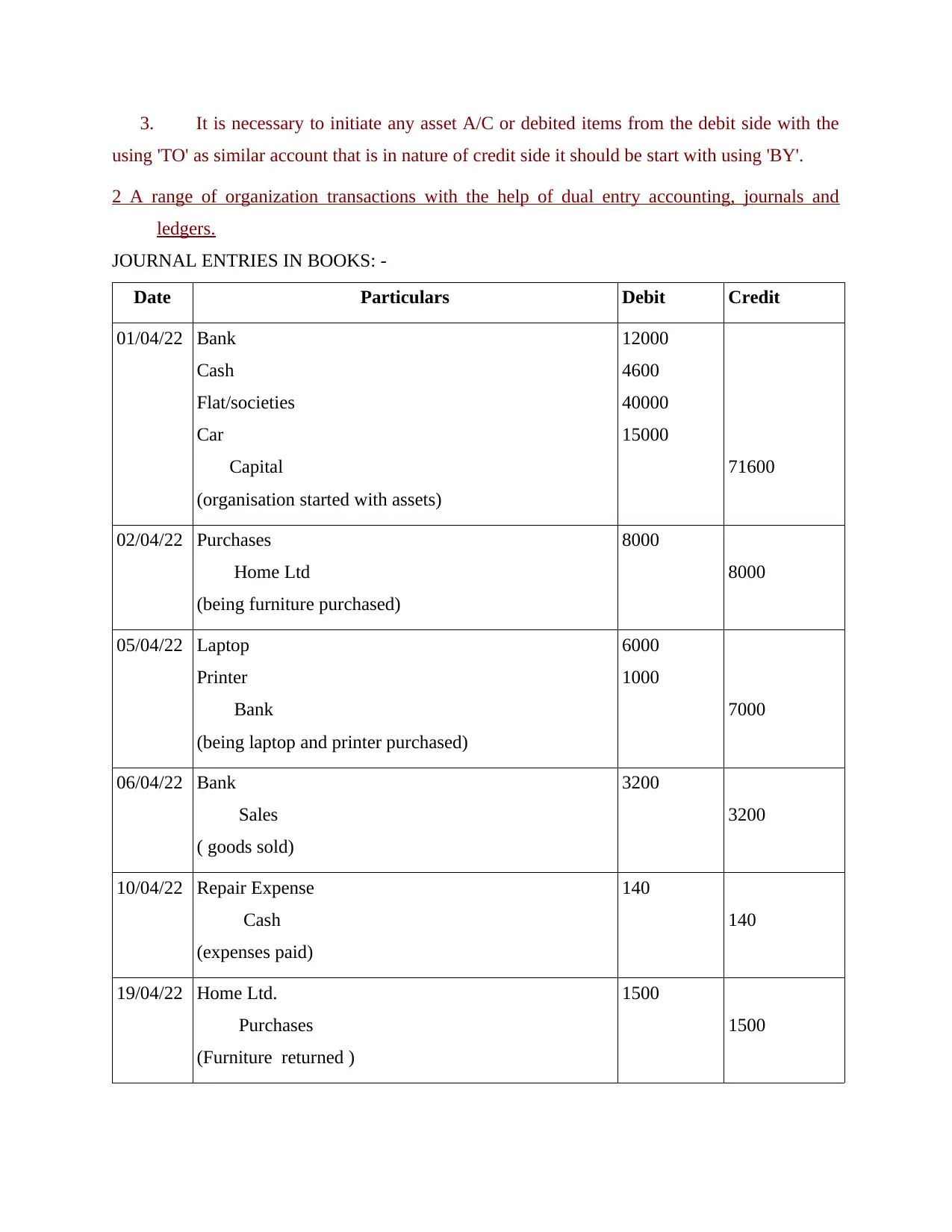
3. It is necessary to initiate any asset A/C or debited items from the debit side with the
using 'TO' as similar account that is in nature of credit side it should be start with using 'BY'.
2 A range of organization transactions with the help of dual entry accounting, journals and
ledgers.
JOURNAL ENTRIES IN BOOKS: -
Date Particulars Debit Credit
01/04/22 Bank
Cash
Flat/societies
Car
Capital
(organisation started with assets)
12000
4600
40000
15000
71600
02/04/22 Purchases
Home Ltd
(being furniture purchased)
8000
8000
05/04/22 Laptop
Printer
Bank
(being laptop and printer purchased)
6000
1000
7000
06/04/22 Bank
Sales
( goods sold)
3200
3200
10/04/22 Repair Expense
Cash
(expenses paid)
140
140
19/04/22 Home Ltd.
Purchases
(Furniture returned )
1500
1500
using 'TO' as similar account that is in nature of credit side it should be start with using 'BY'.
2 A range of organization transactions with the help of dual entry accounting, journals and
ledgers.
JOURNAL ENTRIES IN BOOKS: -
Date Particulars Debit Credit
01/04/22 Bank
Cash
Flat/societies
Car
Capital
(organisation started with assets)
12000
4600
40000
15000
71600
02/04/22 Purchases
Home Ltd
(being furniture purchased)
8000
8000
05/04/22 Laptop
Printer
Bank
(being laptop and printer purchased)
6000
1000
7000
06/04/22 Bank
Sales
( goods sold)
3200
3200
10/04/22 Repair Expense
Cash
(expenses paid)
140
140
19/04/22 Home Ltd.
Purchases
(Furniture returned )
1500
1500
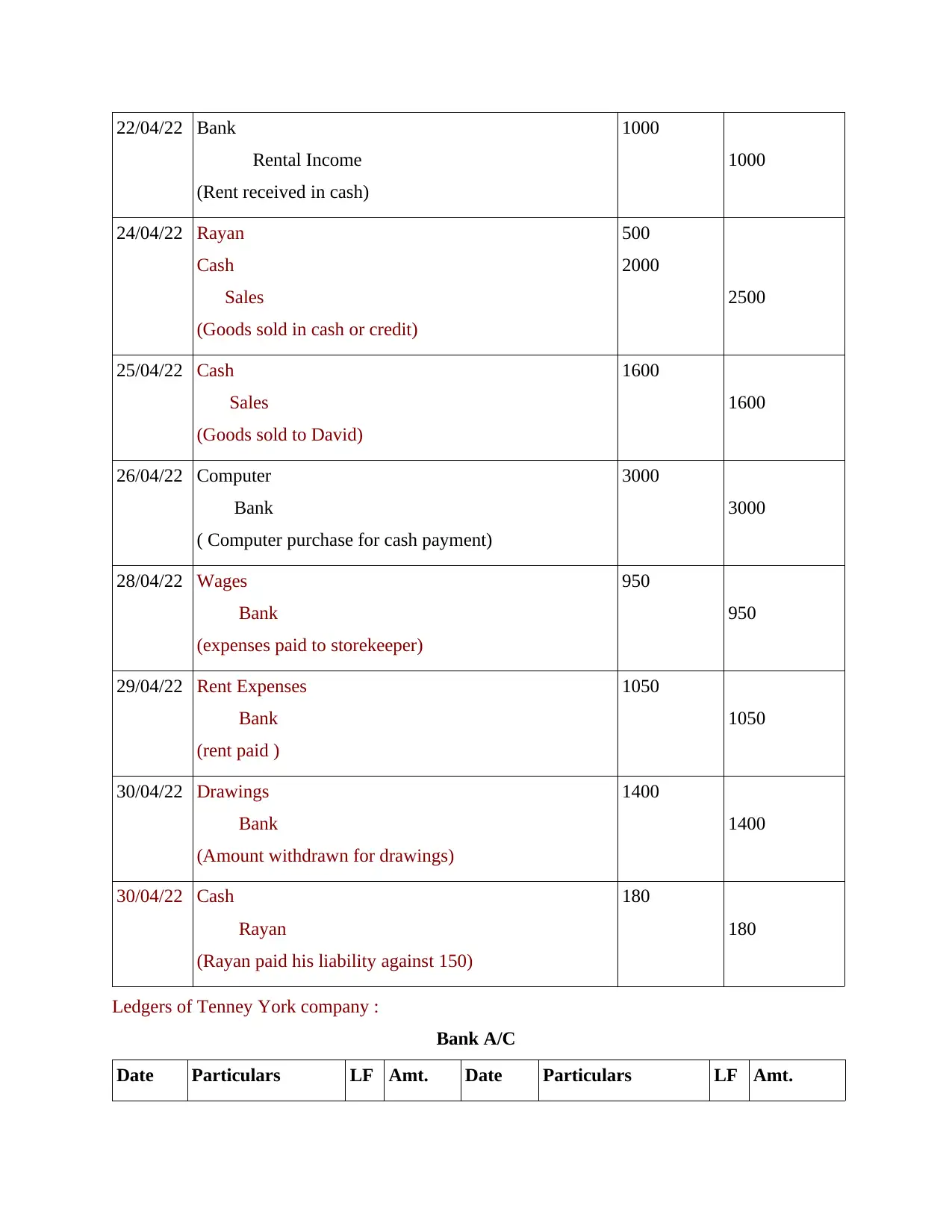
22/04/22 Bank
Rental Income
(Rent received in cash)
1000
1000
24/04/22 Rayan
Cash
Sales
(Goods sold in cash or credit)
500
2000
2500
25/04/22 Cash
Sales
(Goods sold to David)
1600
1600
26/04/22 Computer
Bank
( Computer purchase for cash payment)
3000
3000
28/04/22 Wages
Bank
(expenses paid to storekeeper)
950
950
29/04/22 Rent Expenses
Bank
(rent paid )
1050
1050
30/04/22 Drawings
Bank
(Amount withdrawn for drawings)
1400
1400
30/04/22 Cash
Rayan
(Rayan paid his liability against 150)
180
180
Ledgers of Tenney York company :
Bank A/C
Date Particulars LF Amt. Date Particulars LF Amt.
Rental Income
(Rent received in cash)
1000
1000
24/04/22 Rayan
Cash
Sales
(Goods sold in cash or credit)
500
2000
2500
25/04/22 Cash
Sales
(Goods sold to David)
1600
1600
26/04/22 Computer
Bank
( Computer purchase for cash payment)
3000
3000
28/04/22 Wages
Bank
(expenses paid to storekeeper)
950
950
29/04/22 Rent Expenses
Bank
(rent paid )
1050
1050
30/04/22 Drawings
Bank
(Amount withdrawn for drawings)
1400
1400
30/04/22 Cash
Rayan
(Rayan paid his liability against 150)
180
180
Ledgers of Tenney York company :
Bank A/C
Date Particulars LF Amt. Date Particulars LF Amt.
⊘ This is a preview!⊘
Do you want full access?
Subscribe today to unlock all pages.

Trusted by 1+ million students worldwide
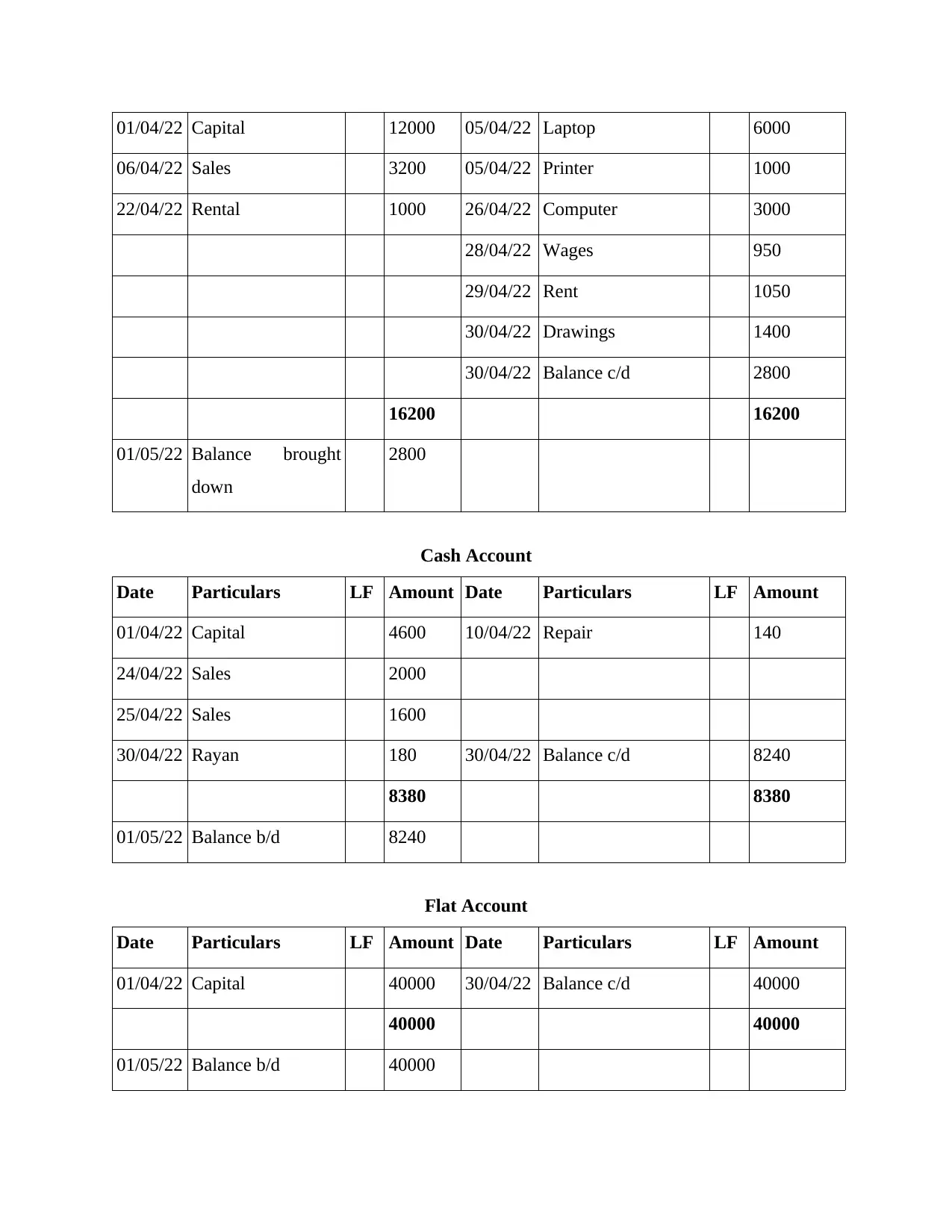
01/04/22 Capital 12000 05/04/22 Laptop 6000
06/04/22 Sales 3200 05/04/22 Printer 1000
22/04/22 Rental 1000 26/04/22 Computer 3000
28/04/22 Wages 950
29/04/22 Rent 1050
30/04/22 Drawings 1400
30/04/22 Balance c/d 2800
16200 16200
01/05/22 Balance brought
down
2800
Cash Account
Date Particulars LF Amount Date Particulars LF Amount
01/04/22 Capital 4600 10/04/22 Repair 140
24/04/22 Sales 2000
25/04/22 Sales 1600
30/04/22 Rayan 180 30/04/22 Balance c/d 8240
8380 8380
01/05/22 Balance b/d 8240
Flat Account
Date Particulars LF Amount Date Particulars LF Amount
01/04/22 Capital 40000 30/04/22 Balance c/d 40000
40000 40000
01/05/22 Balance b/d 40000
06/04/22 Sales 3200 05/04/22 Printer 1000
22/04/22 Rental 1000 26/04/22 Computer 3000
28/04/22 Wages 950
29/04/22 Rent 1050
30/04/22 Drawings 1400
30/04/22 Balance c/d 2800
16200 16200
01/05/22 Balance brought
down
2800
Cash Account
Date Particulars LF Amount Date Particulars LF Amount
01/04/22 Capital 4600 10/04/22 Repair 140
24/04/22 Sales 2000
25/04/22 Sales 1600
30/04/22 Rayan 180 30/04/22 Balance c/d 8240
8380 8380
01/05/22 Balance b/d 8240
Flat Account
Date Particulars LF Amount Date Particulars LF Amount
01/04/22 Capital 40000 30/04/22 Balance c/d 40000
40000 40000
01/05/22 Balance b/d 40000
Paraphrase This Document
Need a fresh take? Get an instant paraphrase of this document with our AI Paraphraser
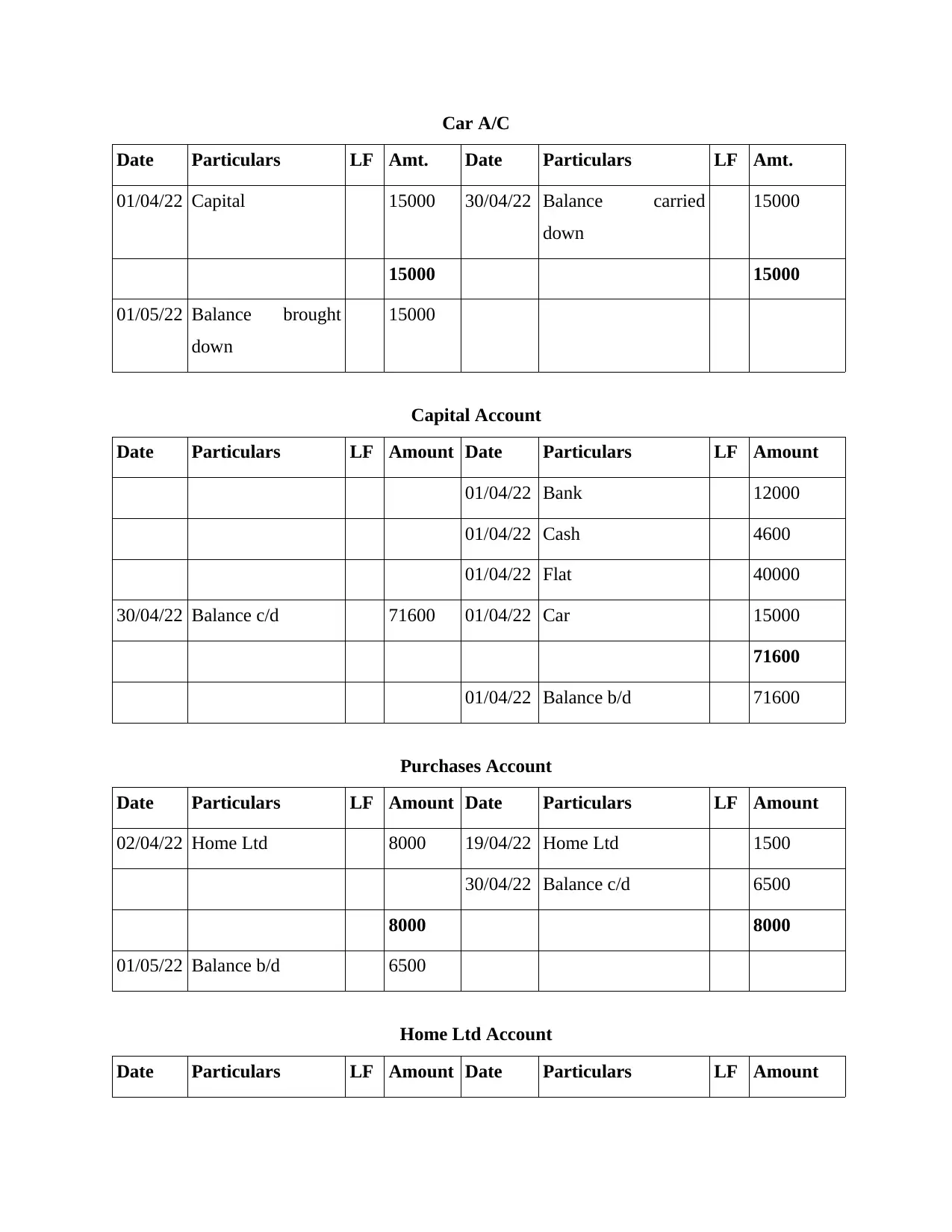
Car A/C
Date Particulars LF Amt. Date Particulars LF Amt.
01/04/22 Capital 15000 30/04/22 Balance carried
down
15000
15000 15000
01/05/22 Balance brought
down
15000
Capital Account
Date Particulars LF Amount Date Particulars LF Amount
01/04/22 Bank 12000
01/04/22 Cash 4600
01/04/22 Flat 40000
30/04/22 Balance c/d 71600 01/04/22 Car 15000
71600
01/04/22 Balance b/d 71600
Purchases Account
Date Particulars LF Amount Date Particulars LF Amount
02/04/22 Home Ltd 8000 19/04/22 Home Ltd 1500
30/04/22 Balance c/d 6500
8000 8000
01/05/22 Balance b/d 6500
Home Ltd Account
Date Particulars LF Amount Date Particulars LF Amount
Date Particulars LF Amt. Date Particulars LF Amt.
01/04/22 Capital 15000 30/04/22 Balance carried
down
15000
15000 15000
01/05/22 Balance brought
down
15000
Capital Account
Date Particulars LF Amount Date Particulars LF Amount
01/04/22 Bank 12000
01/04/22 Cash 4600
01/04/22 Flat 40000
30/04/22 Balance c/d 71600 01/04/22 Car 15000
71600
01/04/22 Balance b/d 71600
Purchases Account
Date Particulars LF Amount Date Particulars LF Amount
02/04/22 Home Ltd 8000 19/04/22 Home Ltd 1500
30/04/22 Balance c/d 6500
8000 8000
01/05/22 Balance b/d 6500
Home Ltd Account
Date Particulars LF Amount Date Particulars LF Amount
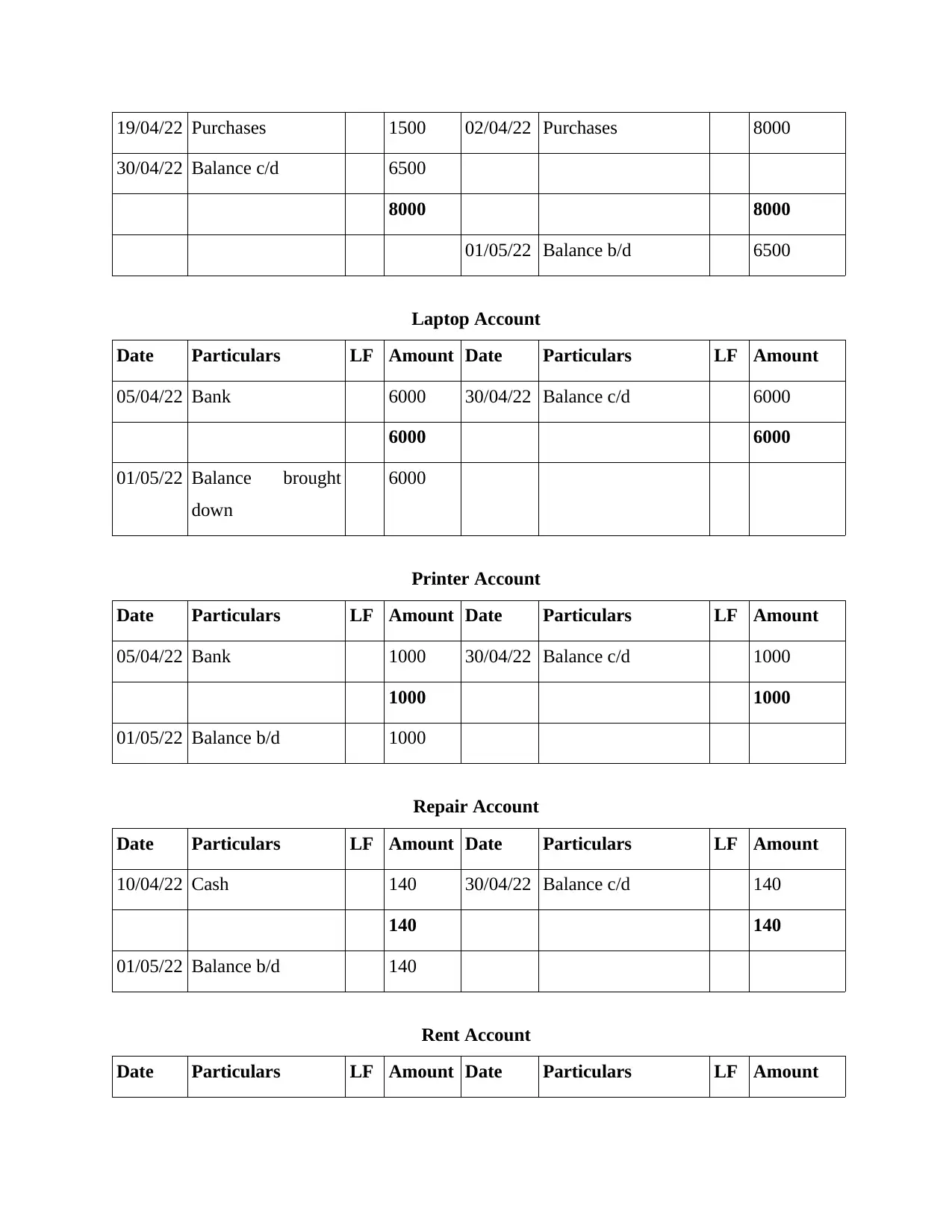
19/04/22 Purchases 1500 02/04/22 Purchases 8000
30/04/22 Balance c/d 6500
8000 8000
01/05/22 Balance b/d 6500
Laptop Account
Date Particulars LF Amount Date Particulars LF Amount
05/04/22 Bank 6000 30/04/22 Balance c/d 6000
6000 6000
01/05/22 Balance brought
down
6000
Printer Account
Date Particulars LF Amount Date Particulars LF Amount
05/04/22 Bank 1000 30/04/22 Balance c/d 1000
1000 1000
01/05/22 Balance b/d 1000
Repair Account
Date Particulars LF Amount Date Particulars LF Amount
10/04/22 Cash 140 30/04/22 Balance c/d 140
140 140
01/05/22 Balance b/d 140
Rent Account
Date Particulars LF Amount Date Particulars LF Amount
30/04/22 Balance c/d 6500
8000 8000
01/05/22 Balance b/d 6500
Laptop Account
Date Particulars LF Amount Date Particulars LF Amount
05/04/22 Bank 6000 30/04/22 Balance c/d 6000
6000 6000
01/05/22 Balance brought
down
6000
Printer Account
Date Particulars LF Amount Date Particulars LF Amount
05/04/22 Bank 1000 30/04/22 Balance c/d 1000
1000 1000
01/05/22 Balance b/d 1000
Repair Account
Date Particulars LF Amount Date Particulars LF Amount
10/04/22 Cash 140 30/04/22 Balance c/d 140
140 140
01/05/22 Balance b/d 140
Rent Account
Date Particulars LF Amount Date Particulars LF Amount
⊘ This is a preview!⊘
Do you want full access?
Subscribe today to unlock all pages.

Trusted by 1+ million students worldwide
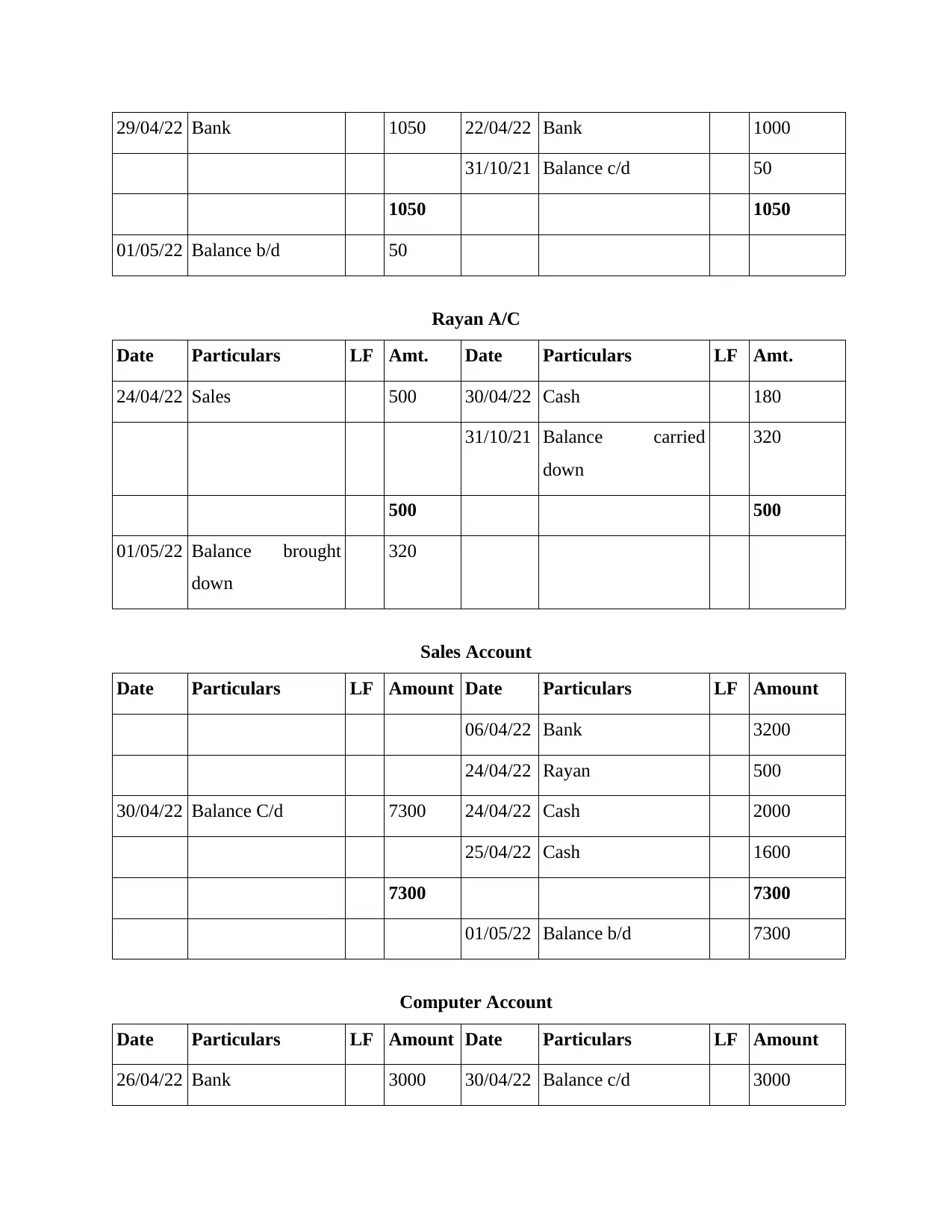
29/04/22 Bank 1050 22/04/22 Bank 1000
31/10/21 Balance c/d 50
1050 1050
01/05/22 Balance b/d 50
Rayan A/C
Date Particulars LF Amt. Date Particulars LF Amt.
24/04/22 Sales 500 30/04/22 Cash 180
31/10/21 Balance carried
down
320
500 500
01/05/22 Balance brought
down
320
Sales Account
Date Particulars LF Amount Date Particulars LF Amount
06/04/22 Bank 3200
24/04/22 Rayan 500
30/04/22 Balance C/d 7300 24/04/22 Cash 2000
25/04/22 Cash 1600
7300 7300
01/05/22 Balance b/d 7300
Computer Account
Date Particulars LF Amount Date Particulars LF Amount
26/04/22 Bank 3000 30/04/22 Balance c/d 3000
31/10/21 Balance c/d 50
1050 1050
01/05/22 Balance b/d 50
Rayan A/C
Date Particulars LF Amt. Date Particulars LF Amt.
24/04/22 Sales 500 30/04/22 Cash 180
31/10/21 Balance carried
down
320
500 500
01/05/22 Balance brought
down
320
Sales Account
Date Particulars LF Amount Date Particulars LF Amount
06/04/22 Bank 3200
24/04/22 Rayan 500
30/04/22 Balance C/d 7300 24/04/22 Cash 2000
25/04/22 Cash 1600
7300 7300
01/05/22 Balance b/d 7300
Computer Account
Date Particulars LF Amount Date Particulars LF Amount
26/04/22 Bank 3000 30/04/22 Balance c/d 3000
Paraphrase This Document
Need a fresh take? Get an instant paraphrase of this document with our AI Paraphraser
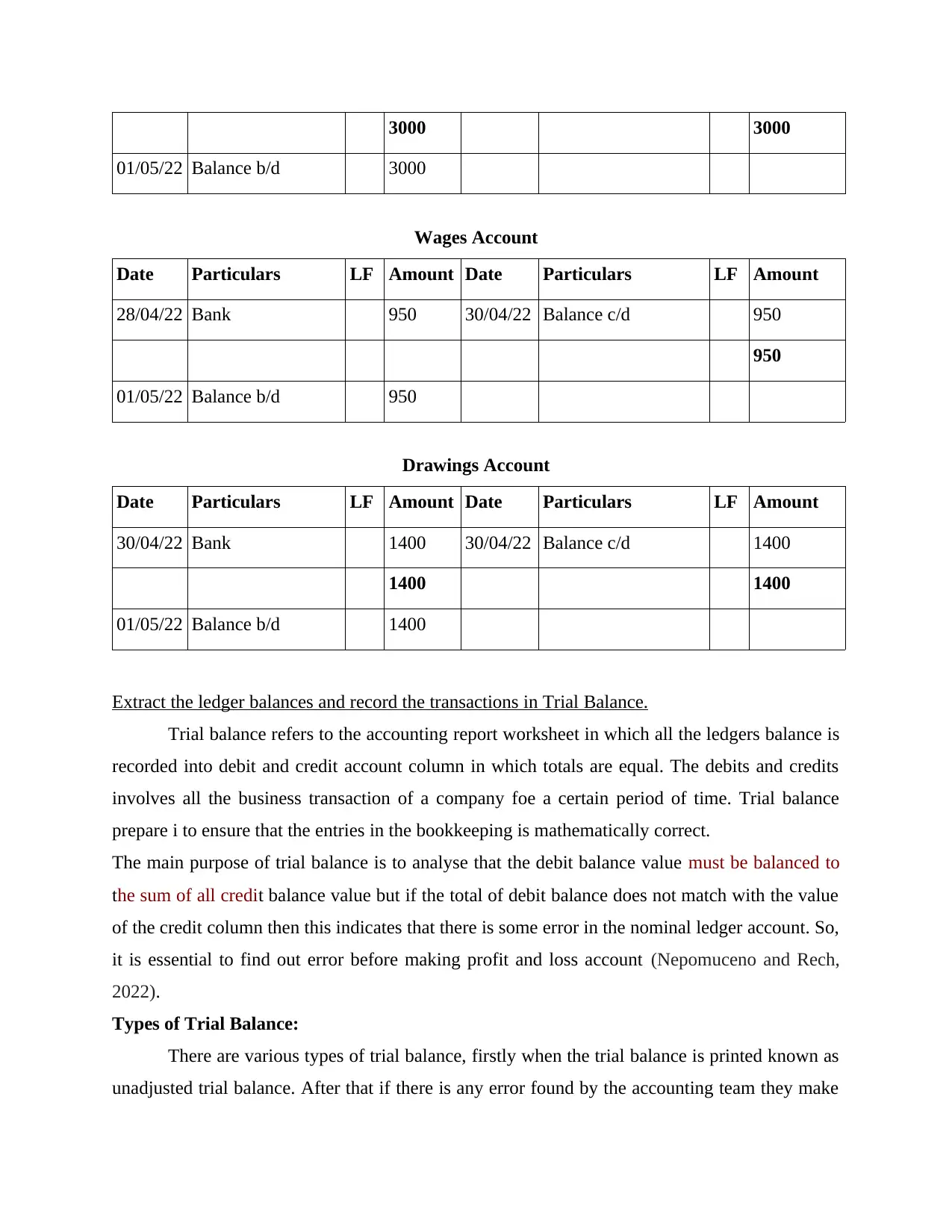
3000 3000
01/05/22 Balance b/d 3000
Wages Account
Date Particulars LF Amount Date Particulars LF Amount
28/04/22 Bank 950 30/04/22 Balance c/d 950
950
01/05/22 Balance b/d 950
Drawings Account
Date Particulars LF Amount Date Particulars LF Amount
30/04/22 Bank 1400 30/04/22 Balance c/d 1400
1400 1400
01/05/22 Balance b/d 1400
Extract the ledger balances and record the transactions in Trial Balance.
Trial balance refers to the accounting report worksheet in which all the ledgers balance is
recorded into debit and credit account column in which totals are equal. The debits and credits
involves all the business transaction of a company foe a certain period of time. Trial balance
prepare i to ensure that the entries in the bookkeeping is mathematically correct.
The main purpose of trial balance is to analyse that the debit balance value must be balanced to
the sum of all credit balance value but if the total of debit balance does not match with the value
of the credit column then this indicates that there is some error in the nominal ledger account. So,
it is essential to find out error before making profit and loss account (Nepomuceno and Rech,
2022).
Types of Trial Balance:
There are various types of trial balance, firstly when the trial balance is printed known as
unadjusted trial balance. After that if there is any error found by the accounting team they make
01/05/22 Balance b/d 3000
Wages Account
Date Particulars LF Amount Date Particulars LF Amount
28/04/22 Bank 950 30/04/22 Balance c/d 950
950
01/05/22 Balance b/d 950
Drawings Account
Date Particulars LF Amount Date Particulars LF Amount
30/04/22 Bank 1400 30/04/22 Balance c/d 1400
1400 1400
01/05/22 Balance b/d 1400
Extract the ledger balances and record the transactions in Trial Balance.
Trial balance refers to the accounting report worksheet in which all the ledgers balance is
recorded into debit and credit account column in which totals are equal. The debits and credits
involves all the business transaction of a company foe a certain period of time. Trial balance
prepare i to ensure that the entries in the bookkeeping is mathematically correct.
The main purpose of trial balance is to analyse that the debit balance value must be balanced to
the sum of all credit balance value but if the total of debit balance does not match with the value
of the credit column then this indicates that there is some error in the nominal ledger account. So,
it is essential to find out error before making profit and loss account (Nepomuceno and Rech,
2022).
Types of Trial Balance:
There are various types of trial balance, firstly when the trial balance is printed known as
unadjusted trial balance. After that if there is any error found by the accounting team they make
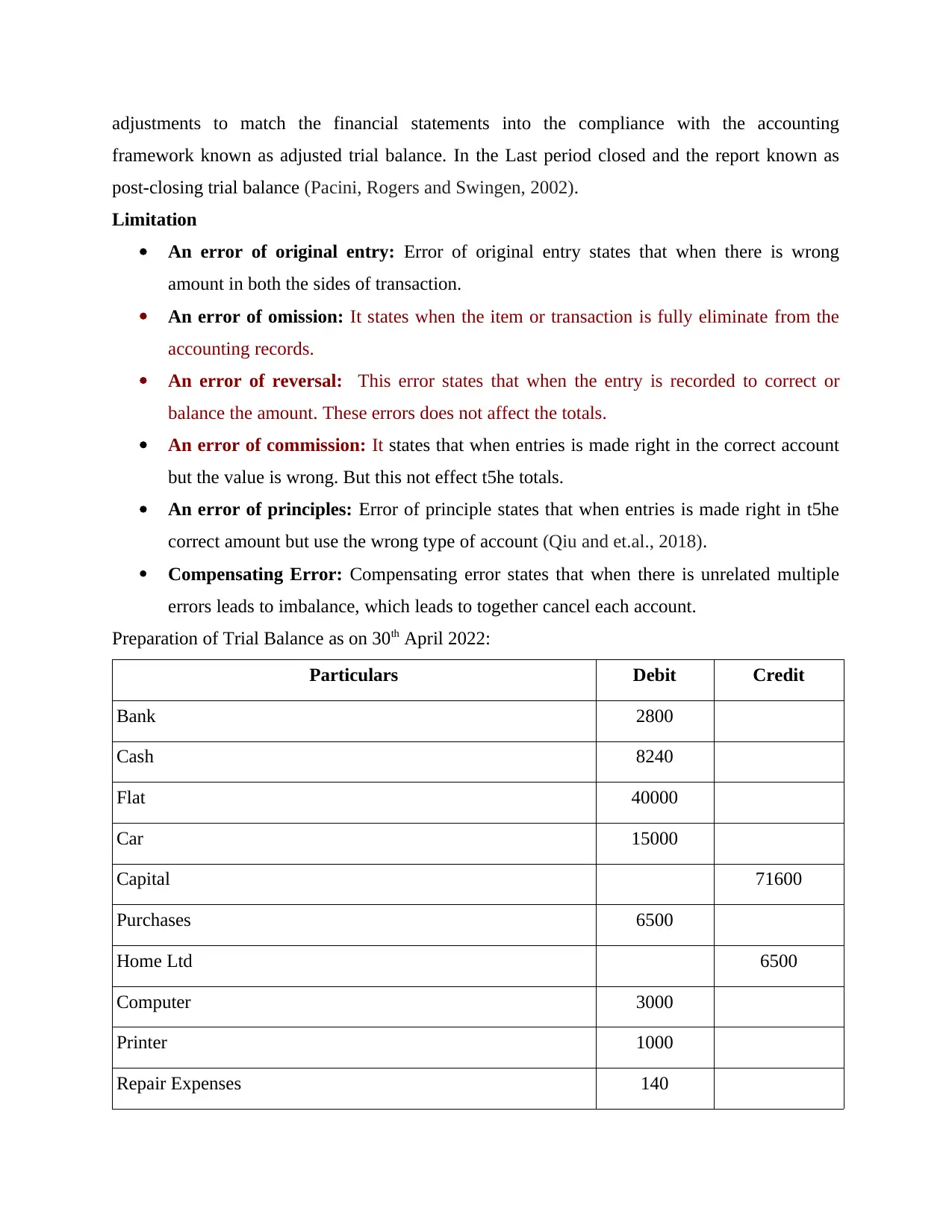
adjustments to match the financial statements into the compliance with the accounting
framework known as adjusted trial balance. In the Last period closed and the report known as
post-closing trial balance (Pacini, Rogers and Swingen, 2002).
Limitation
An error of original entry: Error of original entry states that when there is wrong
amount in both the sides of transaction.
An error of omission: It states when the item or transaction is fully eliminate from the
accounting records.
An error of reversal: This error states that when the entry is recorded to correct or
balance the amount. These errors does not affect the totals.
An error of commission: It states that when entries is made right in the correct account
but the value is wrong. But this not effect t5he totals.
An error of principles: Error of principle states that when entries is made right in t5he
correct amount but use the wrong type of account (Qiu and et.al., 2018).
Compensating Error: Compensating error states that when there is unrelated multiple
errors leads to imbalance, which leads to together cancel each account.
Preparation of Trial Balance as on 30th April 2022:
Particulars Debit Credit
Bank 2800
Cash 8240
Flat 40000
Car 15000
Capital 71600
Purchases 6500
Home Ltd 6500
Computer 3000
Printer 1000
Repair Expenses 140
framework known as adjusted trial balance. In the Last period closed and the report known as
post-closing trial balance (Pacini, Rogers and Swingen, 2002).
Limitation
An error of original entry: Error of original entry states that when there is wrong
amount in both the sides of transaction.
An error of omission: It states when the item or transaction is fully eliminate from the
accounting records.
An error of reversal: This error states that when the entry is recorded to correct or
balance the amount. These errors does not affect the totals.
An error of commission: It states that when entries is made right in the correct account
but the value is wrong. But this not effect t5he totals.
An error of principles: Error of principle states that when entries is made right in t5he
correct amount but use the wrong type of account (Qiu and et.al., 2018).
Compensating Error: Compensating error states that when there is unrelated multiple
errors leads to imbalance, which leads to together cancel each account.
Preparation of Trial Balance as on 30th April 2022:
Particulars Debit Credit
Bank 2800
Cash 8240
Flat 40000
Car 15000
Capital 71600
Purchases 6500
Home Ltd 6500
Computer 3000
Printer 1000
Repair Expenses 140
⊘ This is a preview!⊘
Do you want full access?
Subscribe today to unlock all pages.

Trusted by 1+ million students worldwide
1 out of 18
Related Documents
Your All-in-One AI-Powered Toolkit for Academic Success.
+13062052269
info@desklib.com
Available 24*7 on WhatsApp / Email
![[object Object]](/_next/static/media/star-bottom.7253800d.svg)
Unlock your academic potential
Copyright © 2020–2025 A2Z Services. All Rights Reserved. Developed and managed by ZUCOL.





